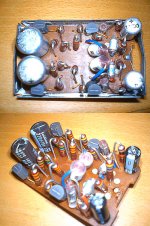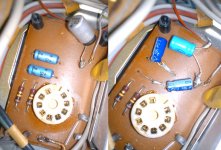That could be difficult to impossible.
You need to see where its getting in first so try with just speakers attached and nothing else connected. Also, is the volume level of interference affected by the volume control ? It is possible the interference is being picked up directly by the semiconductors in the unit... wooden case ? No shielding. No easy fix for that I'm afraid.
Free air space is the most effective, if possible just move the amp and source of interference further apart.
From an experimental point of view if you can locate where in the chain its getting in then it might be possible to do something but its not straightforward. Small (tiny small) ferrite beads on the 'base' of any offending transistor might be effective buts its all trial and error. Another possibility is to use small caps across the base/emitter or sometimes base collector junction of the transistor/s but that needs extreme care as you could turn the stage in question into an oscillator, possibly destructively so in the case of the power amp.
You need to see where its getting in first so try with just speakers attached and nothing else connected. Also, is the volume level of interference affected by the volume control ? It is possible the interference is being picked up directly by the semiconductors in the unit... wooden case ? No shielding. No easy fix for that I'm afraid.
Free air space is the most effective, if possible just move the amp and source of interference further apart.
From an experimental point of view if you can locate where in the chain its getting in then it might be possible to do something but its not straightforward. Small (tiny small) ferrite beads on the 'base' of any offending transistor might be effective buts its all trial and error. Another possibility is to use small caps across the base/emitter or sometimes base collector junction of the transistor/s but that needs extreme care as you could turn the stage in question into an oscillator, possibly destructively so in the case of the power amp.
Ok, message understood.
Drawbacks of vintage amps
I don't know whether it's for shielding purposes or what, but there's a thin aluminium layer on inside surface of the top case. The unit itself sits in a metal frame, but somewhere there's a weak link obviously.
Easiest solution to push the unit away from the source of interference would be where I start. I'll see what I can do.
Thanks
Drawbacks of vintage amps
I don't know whether it's for shielding purposes or what, but there's a thin aluminium layer on inside surface of the top case. The unit itself sits in a metal frame, but somewhere there's a weak link obviously.
Easiest solution to push the unit away from the source of interference would be where I start. I'll see what I can do.
Thanks
If the tuner is working OK then leave it all be, however there are some caps that could be replaced. The modules I marked in red I would leave alone although there are some electros in these to decouple the supply. Unless you could be sure of not disturbing or moving other parts in the can then I would leave them. The ones in green can be safely worked on as there is no RF (radio frequency) alignment in those.
Hey Mooly.
Just wanted to let you know your efforts weren't in vain.
Say half year ago I stumbled upon a pic from this same unit with one of the "transmoduls" case opened. It didn't look like there's a risk to mess it up totally. Ever since the thought of finishing the recap of this amplifier haunted me.
So on last week I finally did it. Removed the transmoduls, opened them and replaced the caps inside of them. Ok one of them I left alone, the one where it said AM, since my amplifier does not support AM. To my great surprise many of the caps inside the transmodules weren't so toasted as I expected. Some of them measured for precisely as what they are supposed to be.
Ok, Riia module had drifted caps. Both 250uF there measured for circa 350uF.
I don't know if it was a bad choice, I used 220uF there, since 250uF is no longer a common size. I got them all done.
Few axial caps that were on the tuner board, underneath the transmodules (to reach solder side would have required a dismounting the whole board with desoldering bunch of wires and ground points) I managed to cut them loose from above and solder them quickly to the legs sticking out.
I have used the amp now for a week or so.
I must say it made a difference; there's a certain FM station I frequently tuned into and I wasn't able to get stereo reception of it before at all. Now tunes in with stereo and it's lot more stable in stereo mode as before it would drift off from stereo. Stereo module had one 10uF cap which measured for about ~12.4uF. Also tolerates the antenna play better, stereo is way more persistent.
Only thing that remains a problem with the unit is the FM signal strength meter that won't budge. Maybe it's not about the caps then. The odds are I can live with it
Here's a two pics of the Riia module.
All good now!
Attachments
Hi...HifiNick...
Good job restoring an old Danish receiver
Just one thing about your interference. A lot of these receivers experienced these problems, even the B&O 3000-4000-4400.
It could be something as simple as the phono input or simply the length of your speaker cables, working as antennas in the 20-50MHz area, sending signals back into the poweramp, where some germanium diodes then could work as detectors. Two simple solutions:
In the phono preamp place a small ceramic cap 20-50pF between base and emitter of the first transistor in the chain (on both channels).
Second, try to reduce the length of the speaker wires to the minimum needed. This has helped a lot of people "back in the days"
Good job restoring an old Danish receiver
Just one thing about your interference. A lot of these receivers experienced these problems, even the B&O 3000-4000-4400.
It could be something as simple as the phono input or simply the length of your speaker cables, working as antennas in the 20-50MHz area, sending signals back into the poweramp, where some germanium diodes then could work as detectors. Two simple solutions:
In the phono preamp place a small ceramic cap 20-50pF between base and emitter of the first transistor in the chain (on both channels).
Second, try to reduce the length of the speaker wires to the minimum needed. This has helped a lot of people "back in the days"
Thanks Boy.
The unit's been in the family since new, so would have been uncomfortable to trash it.
Ok, I guess many vintage amps have these issues with interference.
Mostly interference is at worst from straight above the unit, I tested it.
So kinda bad to say what is exactly the culprit. I think the recap made it worse, as now caps are up to spec.
Do you have any references from other users that fixed the problem, like link to a forum topic maybe? It's not a great problem for me, I can live with this issue.
This is a great amp, very warm sound with strong mid-bass.
This is probably overlooked by many, since it's not so attractive as say Marantz or Japanese vintage amps.
The unit's been in the family since new, so would have been uncomfortable to trash it.
Ok, I guess many vintage amps have these issues with interference.
Mostly interference is at worst from straight above the unit, I tested it.
So kinda bad to say what is exactly the culprit. I think the recap made it worse, as now caps are up to spec.
Do you have any references from other users that fixed the problem, like link to a forum topic maybe? It's not a great problem for me, I can live with this issue.
This is a great amp, very warm sound with strong mid-bass.
This is probably overlooked by many, since it's not so attractive as say Marantz or Japanese vintage amps.
No reference whatsoever 
This is from the days, when the internet, fora´s and similar was never thought about
 .
.
The last I remembered was a Beomaster 4400. This was back in ´79-80-81, so sorry...... Can´t help you there.
But fortunately measuring stuff has gotten cheaper, so most DIY´ers have a better chance of finding the fault, than we had. Good luck to your future upgrades/fixes.
This is from the days, when the internet, fora´s and similar was never thought about
The last I remembered was a Beomaster 4400. This was back in ´79-80-81, so sorry...... Can´t help you there.
But fortunately measuring stuff has gotten cheaper, so most DIY´ers have a better chance of finding the fault, than we had. Good luck to your future upgrades/fixes.
- Status
- This old topic is closed. If you want to reopen this topic, contact a moderator using the "Report Post" button.
- Home
- Amplifiers
- Solid State
- Troubleshooting stereo amplifier

